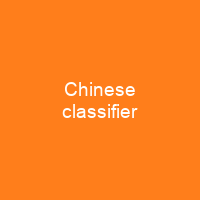Understanding Chinese Classifiers: A Journey Through Language
Imagine a world where every noun needs to be paired with a special word just to count or measure it—sounds intriguing, right? That’s exactly what the Chinese language does through its use of classifiers.
The Basics of Classifiers in Modern Chinese
In modern Chinese varieties, especially Mandarin, nearly all nouns require a classifier when used with numerals or demonstratives. This system is quite different from English, where most nouns can stand alone without such assistance. For instance, you might say “three apples” in English, but in Chinese, it would be something like “三个苹果 (sān gè píngguǒ)”, where 个 (gè) is the classifier for countable objects.
The Two Types of Classifiers
Count-classifiers and mass-classifiers are the two main types, each serving a unique purpose.
- Count-classifiers (个, 张, 条): These are used for countable nouns like “three books” or “two horses.”
- Mass-classifiers (斤, 瓶, 本): These are used for uncountable nouns such as “five kilograms of rice” or “three bottles of water.”
The Evolution and Complexity of Classifiers
Classifiers in Chinese have a rich history. The term 量词 (liàngcí), meaning ‘measure word,’ is used to cover all count-classifiers and mass-classifiers, but the types grouped under this term are not always the same. For example, some classifiers may be reduplicated to mean ‘every,’ or they can indicate possession.
How do these classifiers come into being? Some are derived from free-standing nouns that have lost their original meaning over time, while others are more transparent in their origins. The classifier 个 (gè), for instance, was once a separate word with the meaning of ‘partiality’ or ‘being a single part,’ and it merged with another similar term.
The Role of Classifiers in Everyday Speech
Classifiers play a crucial role in everyday speech. They can express plural or indefinite quantities, modify adjectives, indicate possession, and even convey meanings like ‘all’ or ‘the entire.’
- Plural Indication: Using classifiers after nouns can imply ‘every’ or ‘all,’ such as in “每天 (měitiān) every day.”
- Possession: Classifiers like 个 (gè) can be used to indicate possession, e.g., “我的书 (wǒ de shū) my book.”
The Dialectal Variations and Historical Context
Different dialects in China have varying numbers of classifiers. Northern dialects tend to use fewer classifiers than southern ones. For example, the Dungan language only uses 个 (gè), while some dialects like Northern Min might use 隻 (zhī) for people.
The development of classifiers is believed to have occurred during different periods, with estimates varying among historians. Regardless of when they developed, Wang Lianqing claims that Chinese classifiers did not become grammatically mandatory until around the 11th century.
Conclusion
In summary, understanding and mastering Chinese classifiers can significantly enhance your ability to communicate effectively in Mandarin. These special words are more than just counting tools; they carry deep linguistic and cultural significance. Whether you’re a student of Chinese or simply curious about the language, delving into the world of classifiers will undoubtedly enrich your appreciation for this complex yet fascinating system.

You want to know more about Chinese classifier?
This page is based on the article Chinese classifier published in Wikipedia (retrieved on November 29, 2024) and was automatically summarized using artificial intelligence.







